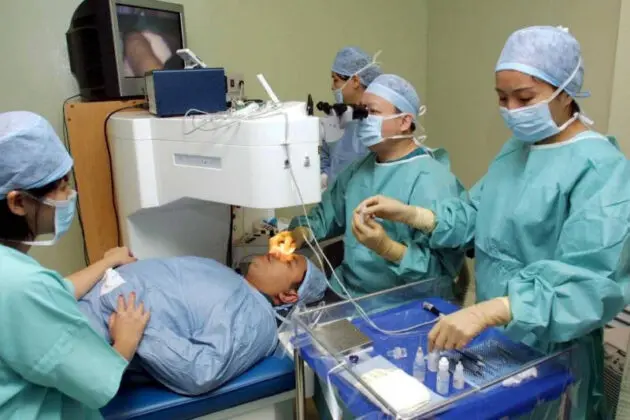
Are you considering Contoura surgery? If so, you’re not alone. This type of surgery is becoming increasingly popular, and for good reason. It can dramatically improve your appearance and make you look younger and more attractive. But what is Contoura surgery, exactly? And what do you need to know before getting it done? In this blog post, we will answer all of your questions about Contoura surgery and help you decide if it’s the right choice for you.
Contents
Contoura surgery is a type of refractive surgery used to correct vision. It is also known as laser-assisted in situ keratomileusis or LASIK. The surgery is performed by an ophthalmologist, a medical doctor who specializes in treating disorders of the eye.
The goal of Contoura surgery is to improve vision so that you no longer need to wear glasses or contact lenses. In most cases, the procedure is successful and patients experience significant improvements in their vision.
Contoura surgery can be used to treat a variety of different refractive errors, including myopia (nearsightedness), hyperopia (farsightedness), and astigmatism.
There are many different types of contour surgery, but they all have one thing in common: they’re used to treat a variety of eye conditions. Some of the most common conditions that Contoura surgery can treat include:
Cataracts are a common eye condition that usually occurs as people age. This condition causes the lens of the eye to become cloudy, which can lead to vision problems. Contoura surgery can be used to remove the cataract and replace it with an artificial lens.
Glaucoma is a serious eye condition that can cause permanent vision loss. This condition occurs when the pressure inside the eye becomes too high, which can damage the optic nerve. Contoura surgery can be used to reduce the pressure in the eye and prevent further damage to the optic nerve.
Age-related macular degeneration (AMD) is a common age-related eye condition that causes vision loss. This condition occurs when the macula, which is the part of the eye responsible for central vision, begins to deteriorate. This type of surgery can be used to improve vision in people with AMD.
Retinal detachment is a serious condition that can cause permanent vision loss. This condition occurs when the retina (the light-sensitive layer at the back of the eye) becomes detached from the rest of the eye. This type of surgery can be used to reattach the retina and prevent further damage to the eye.
Diabetic retinopathy is a common complication of diabetes that can lead to vision loss. This condition occurs when the blood vessels in the retina become damaged, which can cause bleeding and swelling. Also, this type of surgery can be used to repair damaged blood vessels and prevent further vision loss.
Contoura surgery is a minimally invasive procedure that uses small incisions to access the eye. Once the surgeon has access to the eye, they will use a laser to correct any vision problems. The entire procedure usually takes less than an hour, and you should be able to go home the same day.
Another great thing about this type of surgery is that there is no need for stitches. The incisions made during the procedure are so small that they will heal on their own.
There are many benefits of this type of surgery, including:
If you’re considering Contoura surgery, talk to your doctor about whether it’s right for you. They can help you understand the risks and benefits of the procedure and make sure you receive the best care possible.
There are many side-effects of Contoura surgery that can occur. The most common side-effects are:
Other less common side-effects include:
If you experience any of these side effects, it is important to contact your doctor immediately.
While this type of surgery is considered safe, there are always risks involved with any type of surgery. Be sure to discuss all possible risks and side effects with your doctor before having the procedure done. That way, you can make an informed decision about whether or not Contoura surgery is right for you.
There are many alternatives to Contoura surgery. The most common alternative is LASIK. It is a refractive surgery that corrects the vision by changing the shape of the cornea. LASIK can be done for nearsightedness, farsightedness, and astigmatism.
Another alternative is PRK or photorefractive keratectomy. PRK is a laser surgery that corrects vision by reshaping the cornea. It is usually done for people who are not suitable for LASIK surgery.
The last alternative is Intacs. Intacs are tiny plastic inserts that are placed in the clear tissue just beneath the surface of the eye. They are used to treat mild to moderate myopia or nearsightedness. Furthermore, it is a permanent alternative to glasses or contact lenses.
However, you should talk to your doctor about which surgery is right for you.
Concluding, if you are looking to get Contoura surgery then you need to know a few things. Primarily, you need to be sure that the surgeon you go to is experienced and qualified. Secondly, make sure to get all the information about the procedure and what it entails. Finally, be sure to ask questions and voice any concerns you may have before going through with the surgery. With these things in mind, getting Contoura surgery should be a breeze!
If you found this article helpful, please share it with your friends or family members who may be considering Contoura surgery! Thank you for reading and best of luck on your journey to a better vision! 🙂
Please feel free to contact us if you have any additional questions.
Here at Eye Mantra, we have an incredibly skilled team of health care professionals who will be happy to help you out. For any assistance regarding eyes and other related issues, you can reach out to us.
Book an appointment with us immediately by calling +91-9711115191. However, you can even mail us at eyemantra1@gmail.com or visit our site- EyeMantra.